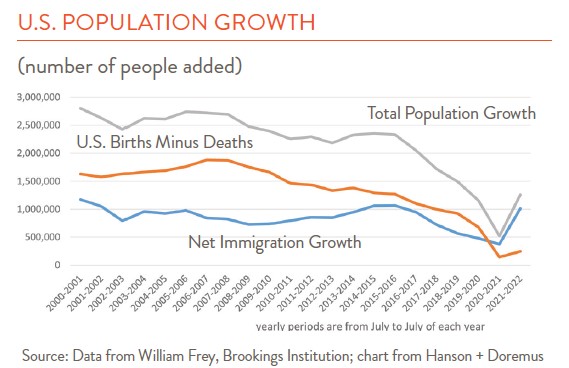U.S. population growth has started edging higher again after hitting an alarming all-time low during the pandemic. According to the latest Census data, from July 2021 to July 2022, the U.S. population grew 0.38%. Admittedly, that’s still not great – it’s one of the lowest growth rates since 1900. But it’s better than the extraordinarily low 0.16% growth we saw during the worst of the pandemic. And one real reason for optimism is that the bulk of the increase came from legal immigration into the U.S., one of our best levers for raising long-term economic dynamism.
We’re still way below where we were a decade ago. Even before Covid, the “natural increase,” or the difference between U.S. births and deaths, was declining sharply thanks to both an aging population and falling birth rates after the Great Financial Crisis. While immigration made up for much of the shortfall early in the 2010s, policy changes led to dramatic declines around 2016 (see chart). That made the 2010s the second slowest period of population growth in U.S. history – even before Covid brought about excess deaths and crushed migration and birth rates.

Since the low point of 2020-2021, there has been a small recovery in births, but deaths have remained elevated as Covid has stayed with us. It’s the recovery in the third element of population growth, immigration, that has been the star of the story. According to William Frey of the Brookings Institution, immigration brought in a million additional people last year while the natural increase, or the difference between births and deaths, added just 245,000.
Immigration matters. Economies need to replenish people as both consumers and workers at an adequate rate, especially as the population ages. Of the three things that affect population – births, deaths, and immigration – immigration is the easiest to manage through policy. Finally, in our current world, where job openings exceed workers, immigration can positively impact labor market and inflation dynamics. Rana Foroohar of The Financial Times recently cited a study by the San Francisco Fed that found the sharp drop in immigration after 2017 led to a 5.5 point increase in the ratio of job vacancies to unemployment.
According to the Migration Policy Institute, the U.S. still is home to more immigrants than any other nation in the world. Spanish still is the most spoken second language, but there’s also a rich array of other languages being spoken (see the map). Finally, immigrants have similar income and education levels to native-born Americans – though newer arrivals are better educated (with a higher percentage with bachelor’s degrees compared to native-borns).

Immigration proponents like pointing out that immigrants start a quarter of the nation’s businesses even though they make up only 13.6% of the population. FT columnist Foroohar says immigrants are risk takers who foster business expansion and alleviate bottlenecks.
Of course, not everyone sees immigration in a positive light – it also can be complex and controversial. But in a world where birth and death rates are hard to control, immigration looks like our best shot at managing the daunting demographic challenges ahead.